View in other NatureServe Network Field Guides
NatureServe
Montana
Utah
Wyoming
Idaho
Wisconsin
British Columbia
South Carolina
Yukon
California
New York
White Crappie - Pomoxis annularis
General Description
The white crappie and its close relative, the black crappie, are very similar in appearance and habit. These flat-bodied sunfishes are native to east-central North America but were introduced to Montana in the early 1900s. The white crappie is found in the eastern one-third of the state in streams, reservoirs, and ranch ponds. They are opportunistic feeders, utilizing plankton when young but switching primarily to fish as they mature. The white crappie is supposed to tolerate muddier waters than the black crappie and for that reason has been planted in some eastern Montana waters.
Species Range
Montana Range
Range Descriptions
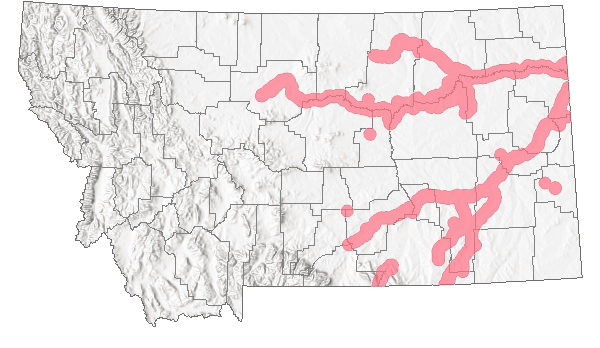
 Non-native
Non-native
Observations in Montana Natural Heritage Program Database
Number of Observations: 299
(Click on the following maps and charts to see full sized version)
Map Help and Descriptions
Relative Density
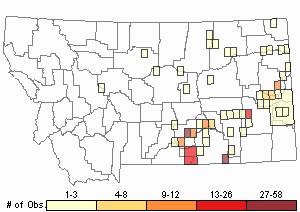
Recency
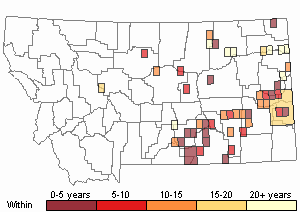
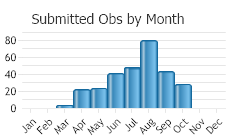
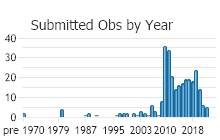
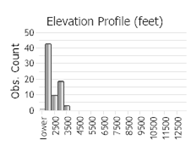 (Observations spanning multiple months or years are excluded from time charts)
(Observations spanning multiple months or years are excluded from time charts)
Migration
May move into tributary streams to spawn. Study on Tongue River showed spawning movement into Otter Creek.
Habitat
Ponds, lakes and reservoirs and slow portions of streams. Seeks weedy areas, logs, and other protective cover. Seems more tolerant of turbid water than Black Crappie.
Food Habits
Mainly microcrustaceans during the 1st year, then largely fish.
Ecology
May cross with black crappie but no hybrids have been reported in Montana. Tributary streams may serve as rearing areas but may produce stunted populations.
Reproductive Characteristics
Sexually mature normally after 2 years. Spawns late spring - early summer at water temperatures of 57-73 degrees F., and is most active at 60-68 degrees F.
Management
Stewardship Responsibility
References
- Additional ReferencesLegend:
 View Online Publication
View Online Publication
Do you know of a citation we're missing? Dieterman, D.J., M.P. Ruggles, M.L. Wildhaber, and D.L. Galat (eds). 1996. Population structure and habitat use of benthic fishes along the Missouri and Lower Yellowstone Rivers. 1996 Annual report of Missouri River Benthic Fish Study PD-95-5832 to U.S. Army Corps of Engineers and U.S. Bureau of Reclamation. 238 p.
Dieterman, D.J., M.P. Ruggles, M.L. Wildhaber, and D.L. Galat (eds). 1996. Population structure and habitat use of benthic fishes along the Missouri and Lower Yellowstone Rivers. 1996 Annual report of Missouri River Benthic Fish Study PD-95-5832 to U.S. Army Corps of Engineers and U.S. Bureau of Reclamation. 238 p. Duncan, M.B. 2019. Distributions, abundances, and movements of small, nongame fishes in a large Great Plains river network. Ph.D. Dissertation. Bozeman, MT: Montana State University. 255 p.
Duncan, M.B. 2019. Distributions, abundances, and movements of small, nongame fishes in a large Great Plains river network. Ph.D. Dissertation. Bozeman, MT: Montana State University. 255 p. Holton, G.D. 1981. Identification of Montana's most common game and sport fishes. Montana Outdoors May/June reprint. 8 p.
Holton, G.D. 1981. Identification of Montana's most common game and sport fishes. Montana Outdoors May/June reprint. 8 p. Joslin, Gayle, and Heidi B. Youmans. 1999. Effects of recreation on Rocky Mountain wildlife: a review for Montana. [Montana]: Montana Chapter of the Wildlife Society.
Joslin, Gayle, and Heidi B. Youmans. 1999. Effects of recreation on Rocky Mountain wildlife: a review for Montana. [Montana]: Montana Chapter of the Wildlife Society. Knight, D.E. 1982. Accumulation of dietary methylmercury by Walleye and White Crappie in the Tongue River Reservoir, Montana. M.Sc. Thesis. Bozeman, Montana: Montana State University. 103 p.
Knight, D.E. 1982. Accumulation of dietary methylmercury by Walleye and White Crappie in the Tongue River Reservoir, Montana. M.Sc. Thesis. Bozeman, Montana: Montana State University. 103 p. Mullins, M.S. 1991. Biology and predator use of cisco (Coregonus artedi) in Fort Peck Reservoir, Montana. M.Sc. Thesis. Bozeman, MT: Montana State University. 68 p.
Mullins, M.S. 1991. Biology and predator use of cisco (Coregonus artedi) in Fort Peck Reservoir, Montana. M.Sc. Thesis. Bozeman, MT: Montana State University. 68 p. Penkal, R.F. 1977. Black bass populations of the Tongue River Reservoir, Montana. M.Sc. Thesis. Bozeman, MT: Montana State University. 111 p.
Penkal, R.F. 1977. Black bass populations of the Tongue River Reservoir, Montana. M.Sc. Thesis. Bozeman, MT: Montana State University. 111 p. Stash, S.W. 2001. Distribution, relative abundance, and habitat associations of Milk River fishes related to irrigation diversion dams. M.Sc. Thesis. Bozeman, MT: Montana State University. 82 p.
Stash, S.W. 2001. Distribution, relative abundance, and habitat associations of Milk River fishes related to irrigation diversion dams. M.Sc. Thesis. Bozeman, MT: Montana State University. 82 p. USDI Bureau of Land Management. No date. Fishes of the Miles city, Montana BLM District. Miles City, MT: Miles City BLM District pamphlet. 12 p.
USDI Bureau of Land Management. No date. Fishes of the Miles city, Montana BLM District. Miles City, MT: Miles City BLM District pamphlet. 12 p. Wuellner, M.R. 2007. Influence of reach and watershed characteristics on fish distributions in small streams of eastern Montana. M.Sc. Thesis. Bozeman, MT: Montana State University. 80 p.
Wuellner, M.R. 2007. Influence of reach and watershed characteristics on fish distributions in small streams of eastern Montana. M.Sc. Thesis. Bozeman, MT: Montana State University. 80 p. Young, B.A., T.L. Welker, M.L. Wildhaber, C.R. Berry, and D. Scarnecchia (eds). 1997. Population structure and habitat use of benthic fishes along the Missouri and Lower Yellowstone Rivers. 1997 Annual report of Missouri River Benthic Fish Study PD-95-5832 to U.S. Army Corps of Engineers and U.S. Bureau of Reclamation. 207 p.
Young, B.A., T.L. Welker, M.L. Wildhaber, C.R. Berry, and D. Scarnecchia (eds). 1997. Population structure and habitat use of benthic fishes along the Missouri and Lower Yellowstone Rivers. 1997 Annual report of Missouri River Benthic Fish Study PD-95-5832 to U.S. Army Corps of Engineers and U.S. Bureau of Reclamation. 207 p.
- Web Search Engines for Articles on "White Crappie"
- Additional Sources of Information Related to "Fish"





